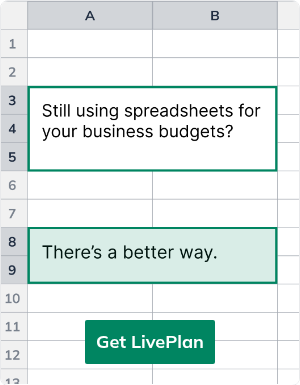17 Key Business Metrics You Need to Track

Jump to
Building a business is a roller coaster of emotions and challenges. One day you’re up on the high of landing a big client. The next you’re down, dealing with an HR issue or scrambling to find a new supplier.
Amid all that turmoil, you must keep the ship on course toward your long-term goals. You need to know if your business is headed in the right direction, or if things need to be corrected.
While many business owners talk about running their businesses on “gut” and “instinct,” truly successful entrepreneurs rely on data and a selection of key business metrics.
Why track business metrics?
Tracking business metrics helps you run your business better
The right metrics:
Give you insight into the health of your business
Help you make informed decisions
Proactively identify areas to improve
Track progress toward goals
If you’re not tracking anything, you are flying blind and risk missing positive trends or critical issues that could impact your success.
Key business metrics to keep in mind
Here are 17 business performance metrics that matter for small business owners. Click the links to jump to specific business metric examples and definitions.
Not all metrics apply to all business types, so figure out which metrics work for your business and just track those.
It’s OK to start small. Even if you just start by tracking one metric, it will help improve your business performance.
Growth metrics
The following business metrics are best for measuring business growth.
1. Active users or repeat customers
For a content website or subscription business, tracking how many active users you have shows how engaged your customers are with your site or product.
If a large portion of users are paying but not “active” – that is, not regularly using your product–you might have a problem. These people aren’t finding your service useful and might cancel their subscriptions.
If you run a retail store, tracking repeat customers is a similarly effective business metric.
You don’t want people to buy once, not be satisfied, and never come back. You want repeat customers because getting a customer’s business the second time is almost always cheaper and easier.
Tip: Compare active users month-to-month to determine if engagement increases or decreases over time.
2. Conversion rates
This is a broad but extremely useful business metric. A conversion rate is simply the number of people who see an offer, divided by the number of people who actually take action.
For example, in advertising, if 100 people see an online ad and five people click, you have a five percent conversion rate for that ad.
Conversion rates are incredibly useful for tracking success in marketing efforts, progress through online shopping carts, converting users from free products to paid products, and much more.
You can even measure conversion rates in physical retail stores by tracking browsers versus buyers.Tip: Focus on improving a particular process when tracking conversion rates so you can quickly measure success and take action.
3. Customer acquisition costs (CAC)
No, CAC is not the sound your cat makes when it’s coughing up a hairball.
It stands for Customer Acquisition Cost. It’s the average amount of money you spend to acquire a single customer.
So, if you spend $1,000 on Google ads and get 100 new customers from that effort, your CAC would be $10.
Ideally, you want to figure out how to reduce your CAC over time. That way you improve your return on investment (ROI) and make your business more profitable.
4. Average revenue per user (ARPU)
You don’t have to have “users” for this metric to matter to you. You could have customers, and you’re tracking average revenue from each customer over a given period, usually one month.
So, if you booked $20,000 in revenue last month from 500 customers, your ARPU would be $40. This is a number you want to improve over time—you want your customers to buy more or sign up for higher price tiers.
5. Lifetime value (LTV)
How much are your customers worth to you over time? Do they subscribe to your service for a year and then quit? Do they buy from you four or five times and then never come back again?
Lifetime Value (or customer lifetime value CLV), is the average value a customer will be to you over their “lifetime” of being your customer.
The most basic way to calculate LTV is by multiplying your customers’ current value per month (ie. how much money they’ve spent in an average month) by the average lifespan in months of all customers. If you’ve been in business for a while, you likely have the data to run this calculation. If not, there are ways to predict it using elements of your sales forecast.
6. Churn
A person “churns out” when they cancel their subscription or stop being a customer. Churn rate is measured by dividing the number of customers you have by the number of customers who cancel.
Churn is similar to another business metric known as the customer retention rate. The key difference is that churn measures all customers leaving, while retention rate tends to prioritize measuring how many new customers end up sticking.
Churn is a slightly complex topic, so I recommend checking out this guide explaining how to reduce your churn rate and improve revenue.
7. Unit economics
This sounds complicated, but it’s not. If you know the Lifetime Value (LTV) of your customers and you know how much it costs to acquire customers (CAC), then you can do a “unit economics analysis.”
Unit economics is just a fancy way of saying, “Are you making more from your customers over time than it costs to acquire your customers?”
For example, it might cost you $100 to get a new customer, but that customer will spend $300 with you over time. The unit economics for this customer is simply the ratio of LTV-to-CAC, in this case, $300:$100, a 3x ratio.
8. Referrals
For most businesses, their best source of new business is referrals from existing customers.
I’m sure you’ve told your friends about the last great meal you had, or about a new online service that’s saving you a ton of time. Done right, this type of marketing is nearly free and more powerful than any advertisement, so it’s worth tracking if you can.
Find out who is referring your product and why they think it’s great. Use that data to build things that customers want.
You can also use the percentage of new customers who come to you from referrals as a measure of how good your overall customer experience is.
If referrals start dropping, perhaps something with your product, store, or customer service isn’t quite right.
9. Net Promoter Score
This marketing metric is related to referral tracking.
Net Promoter Score (NPS) measures how likely your customers are to recommend your product or service to a friend. You use a simple survey to get the raw data and measure the results on a simple 1 to 10 scale.
The question asked is, “How likely are you to recommend us to your friends?” A score of 1 is the worst and 10 is the best.
When you’ve surveyed your customers, group the results into these buckets:
•Detractors: scores 0-6
•Passive: scores 7-8
•Promoters: scores 9-10
Calculate the percentage of your customers that are promoters and then subtract the percentage that are detractors. That’s your score.
You want your number to be positive and try and push it as high as possible. 100 is the highest score you can get, but 50 is considered excellent.
10. Sources of traffic or customers
I talked briefly about customers that come from referrals. You’ll also want to know all the other places your customers come from.
Beyond word of mouth, are there:
Advertising channels that work for you?
Trade shows that help bring in new business?
Publications that generate website traffic?
Track which sources bring in customers and which are just a waste of money so you can focus on what works and stop spending time and money on what doesn’t.
Business health metrics
All of the metrics above are excellent growth metrics worth tracking, but at the end of the day, you need to focus on the actual money that flows in and out of your business.
Here are the business metrics to watch that keep your business alive:
11. Cash and cash flow
In business, cash is king.
If your bank account gets to $0, you’re in big trouble. So, if you track nothing else, keep track of your cash flow.
Very closely related is your cash flow, which is the amount of money that moves in and out of your business during a given time period—usually a month. It’s a key indicator of your financial health.
12. Accounts payable (AR) and accounts receivable (AP)
AR and AP are very closely related to cash flow and are key guides to your company’s health.
In a nutshell, Accounts Payable (AP) is how much money you owe to your suppliers—basically the bills that you need to pay.
Accounts Receivable is money that is owed to you—typically invoices that you have sent out to customers but that haven’t been paid yet. Ideally, you don’t want either of these numbers to grow too much because that means that either you aren’t paying your bills or that your customers aren’t paying you on time.
You can learn more in my detailed posts on accounts receivable and accounts payable.
13. Burn rate and cash runway
Leave it to Silicon Valley to come up with these dramatically named metrics. They’re really quite simple, though.
Burn Rate is how much money you’re spending over and above what you’re making. This number is pretty important for startups because they’re typically spending more than they’re making in the early days.
Cash Runway is simply looking at your cash in the bank and figuring out how long your business can last at its current burn rate. Basically, you need your business to “take off” and start earning its keep before cash runs out.
14. Gross margin
Less complicated than it sounds, Gross Margin is the difference between what it costs you to make what you sell and the revenue that you bring in.
So, if you make bike parts, your costs are everything related to the actual manufacturing process of those parts. Subtract your costs from your sales and you have gross margin.
Gross margin helps you keep on top of how efficient you are as a company. Perhaps you can drive up gross margin by finding more efficient or cheaper ways to build your product, giving you more money to spend on other parts of the business.
15. Inventory turns
If your business carries inventory, you’ll need to track Inventory Turns. This is typically calculated by dividing the cost of goods sold for a period against the average inventory for that same period.
People typically measure inventory turns in annual cycles. This number tells you if you’re building up too much inventory or if demand for your products is slowing down.
16. Profit
No, I haven’t forgotten profit. If you’re tracking your numbers, you’ll certainly be tracking your bottom line. Ideally, with an up-to-date profit and loss statement that you can look at month-to-month.That said, a word of caution: don’t confuse profits with cash. They aren’t the same thing and it’s very important to understand the difference.
17. Customer concentration
I’ve seen companies go under because they didn’t pay enough attention to this metric.
Customer Concentration is the percentage of revenue you get from your largest customer or the top couple of customers. If the percentage is too high, you’ve got too many eggs in one basket and you should be looking to expand your customer base.
You don’t want your business to fail just because you lose one customer.
Tips when tracking business metrics
Test everything
It’s one thing to track metrics, but it’s another thing to improve them.
The only way to move the needle is to try new things and the best way to do that is with A/B testing. Try new landing pages, new advertising headlines, or even new store layouts.
Track and measure your results and figure out what works and what doesn’t. The key to testing is knowing what metric you’re trying to impact. Is it your conversion rate or perhaps your average revenue per user? Use testing to optimize your metrics and grow your business.
Only deal with significant numbers
It’s tempting to make some changes to your business, see the initial results, and come to the conclusion that the changes you made were great (or terrible). That might not be the case, though.
If you don’t have enough data, or if your data isn’t statistically significant, you might draw the wrong conclusions.
Ask questions
What action would I take? The only metrics that matter are the ones that you actually take action on.
Just skip the vanity metrics that you can’t (or won’t) do anything about. The best litmus test I’ve found to determine if I should track a particular number is to ask myself, “If this number goes up (or down), what would I do?”
If there’s nothing specific I would do, then I don’t track the number. Only track the numbers that help you make decisions. If you’re not sure what those are, start with the metrics that are included in your business plan.
Track your progress frequently
Tracking your progress not only gives you more opportunities to improve your business, it’s been proven to help you actually attain your business goals. The research reports that the more frequently you measure your results, the better you will do.
So, once you’ve identified the metrics that are the key drivers of growth in your business, make sure you measure them and track them as often as you can—at least monthly, but perhaps weekly for some numbers.
Real-time insights will help you adapt to challenges quickly and take advantage of opportunities when they come up.
Track business metrics with a financial dashboard
Every business is unique and will have specific things that drive success. But, the metrics listed here should give you a good start.
However, these business metrics are only useful if you have an easy way to track them. You can do this manually with a spreadsheet (and we have several templates to help you do that) but the better option is a business dashboard.
For a simple pre-built performance dashboard, with 22 unique trend reports, consider using LivePlan. It will help you visualize your financial metrics, automatically update with real-time data, and connect everything back to your financial statements and forecasts.

By investing in a business dashboard, you will focus on the metrics that matter, get immediate insights about your business, and make more confident strategic decisions.
FAQ
What are metrics in business?
Business metrics are quantitative measures used to track performance, progress, or outcomes. They help you assess the success of business activities and inform decision-making.
What is the most important metric for a business?
The most important metric depends on your business’s goals, but if it comes down to a single metric cash flow is the most critical since it’s representative of your company’s financial health.
How do you track your business performance?
Business performance is tracked by setting measurable Key Performance Indicators (KPIs) and using performance dashboards, financial reports, and customer feedback to track and review your metrics.
More in Planning

planning
How To Write a Business Plan for a Life Coaching Business + Free Example

planning
How to Write a Small Restaurant Business Plan + Free Sample Plan PDF
planning
How to Write a Cannabis Business Plan + Free Sample Plan

planning









